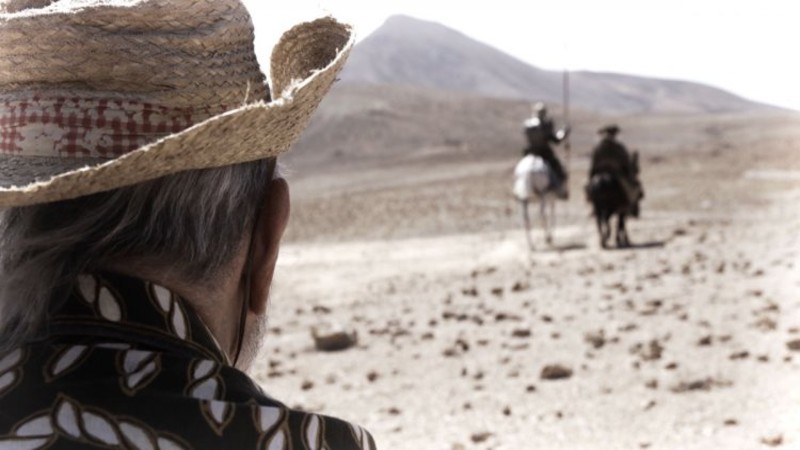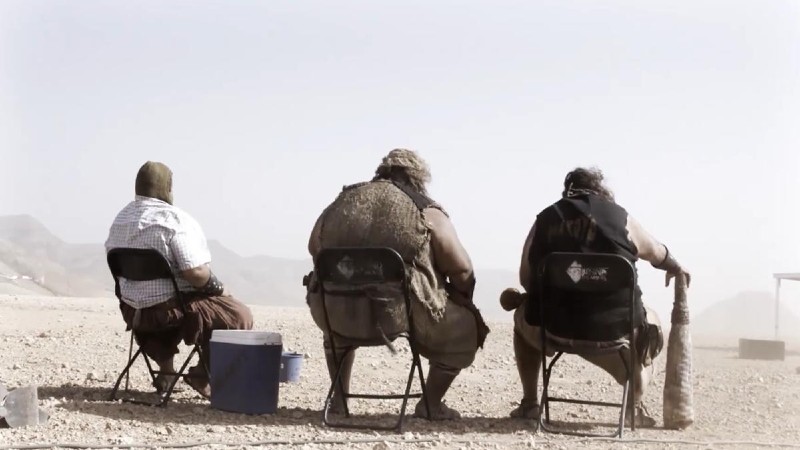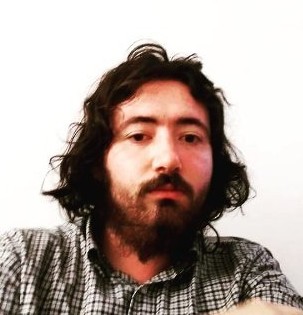




Chronicling American-born British filmmaker Terry Gilliam’s 30-year crusade to make The Man Who Killed Don Quixote (2018), directors Keith Fulton and Louis Pepe demonstrate a director every bit as infallible as the character that captured his creative muse for so long. Without detracting from the film itself, Fulton & Pepe’s He Dreams of Giants (2021) is less interested in the man who conjured Don Quixote. Instead, the two men focus their attention on the artist who dreamed the most impossible of dreams. Long time Gilliam fan Eoghan Lyng caught up with the documentarians to discuss their personal journey on a film set driven by bravery, boast and braggadocio.
He Dreams of Giants is out on Digital platforms on Monday, March 29th, via Blue Finch Film Releasing.
…
.
Eoghan Lyng – To start our conversation, is it fair to say that Terry Gilliam’s The Man Who Killed Don Quixote is as much “quixotic”, as it is “chaotic”?
Louis Pepe – That’s a very good play on words. Keith, would you like to take this one?
Keith Fulton – I guess you could call it “Quixotic”. We were such big fans of Brazil (1985) and Terry’s other films, and the idea of the dreamer coming up against the harshness of reality was always in the background. And, you know, with the second film, we were very much thinking about Don Quixote all the time…I went back and re-read Don Quixote-which I read in 2000, and re-read in 2017- and the “Quixotic” elements were definitely on my mind. Even though, as a 50-year-old reading that, I saw something quite different as I had a 30-year-old reading it.
OL – Do you think Jonathan Pryce might be Terry Gilliam’s muse, considering how brilliantly he brought such vitality to Brazil and Baron Munchausen?
KF – They certainly seem to have a lot of fun working together….Obviously we didn’t get to see Terry working with Jonathan on any films but this one. He has a lot of trust in Jonathan. He lets Jonathan have a lot of free reign… But muse? I don’t know. Jonathan Pryce in Brazil and certainly in this film has played Gilliam’s alter ego.
OL – Asking as an Irishman, where did you come across so many clips of Terry Wogan?
LP – Part of that was…We wanted to create a sense of Terry Gilliam’s past. We did a lot of looking into archival clips where Terry talked about his creative process, and I guess it was on Terry Wogan’s show that Terry Gilliam used to have a bit of a platform to talk about his experience as a filmmaker, and it’s where he used a lot of his soundbite material.
OL – Terry Wogan was such a consummate professional interviewer.
KF – We were not familiar with him before we started working on this. Is he still alive?
OL – No, he died in 2016.
KF – Ok…
OL – Having lived through a sweltering summer myself in Madrid, I can hazard that the climate can’t have helped Gilliam’s temperament. Were you there filming in the sweltering Spanish heat?
KF – Sweltering heat? We were on the Canary Islands for a proportion of the movie . So, it wasn’t sweltering heat; it was merciless wind!
OL – Oh, God!
LP – Wind & sand, yes!

KF – We did some filming in and around Madrid, but it wasn’t sweltering heat…
LP – No, because it was winter time! We went in January. In Lost In La Mancha [Fulton and Pepe’s 2002 documentary about the making of Terry Gilliam’s first attempt at The Man Who Killed Don Quixote] we got the sweltering heat. And then on Dreams of Giants, the wind storms were the thing: the Biblical plague that we were privy to!
OL – How do you think the new version starring Pryce and Adam Driver differed from the original starring Jean Rochefort and Johnny Depp? Was there a different energy?
LP – Well, of course there was no finished film the first time around. But just comparing the energy on the set….I’m just trying to remember how it differed….
KF – It truly is, as you see in He Dreams of Giants, our focus was almost exclusively on what was going on in Terry Gilliam’s head. When we were working on Lost In La Mancha, we were more curious as to what the film Terry was making. This time around we were trying to focus on the incredible burden of history that Gilliam’s carrying with him at the beginning of this production. So, the film that he was making was not a very strong focus.
LP – But I think Terry was more at ease in a way with Jonathan Pryce and Adam Driver embodying the characters, but he had a deeper conflict that he was facing that as Keith says was very much an internal thing going on. He didn’t have the weight of history on his shoulders when he was making the 2000 version that he had when he went into production for the 2017 version.
OL – And the fact that Palin, Hurt and Duvall had all dropped out couldn’t possibly have made it any easier?
LP – Yeah!
DM – Gilliam is astonishingly frank about how far his star has faded in recent years. Did he need to be coaxed into appearing as honest as he appears on camera?
KF – No, that’s Terry. That’s what makes him such a great documentary subject- he doesn’t pull any punches. All the conversations we have with him are always incredibly freeing. That’s one of the reasons why we’ve always admired him so much. I think a lot of people in his position make a pretense that there’s no great conflict going on underneath the surface. Terry, it’s always on the surface. He speaks openly. I think this is a problem with a lot of late career artists. Your audience starts to feel like: “Ok, you’ve done what you’ve needed to do”, “You don’t have anything left to express”, ”You’re not as good as you used to be..” And that’s a terrible burden for artists. Most artists just want to keep doing what they do. It makes them happy. As an audience, as a culture, we “retire” a lot of them before they really want to. Why should they “retire”?
DM – Paul McCartney’s still making records, and some of them are the best of his career.
KF – Particularly musicians, we don’t like to see rock musicians getting old. “Oh my God, he’s still on the stage? He isn’t cute anymore. Rock isn’t for old people!” Similarly, they think that movie-making isn’t for old people: they [older artists] don’t have the stamina for it. Terry speaks openly about all these issues, and I think it’s rare. I don’t think a lot of people involved in filmmaking show this kind of openness.
DM – He Dreams of Giants reminded me of Hearts of Darkness: A Filmmaker’s Apocalypse (Eleanor Coppola, George Hickenlooper and Fax Bahr, 1991), the film that demonstrated the making of Apocalypse Now. Was that an influence on your work?
LP – We’ve always watched the documentaries about filmmaking. I think the one that has had more of an influence on us is Les Blank’s Burden of Dreams (1982), and I think more the influence – especially on He Dreams of Giants – comes from having seen Terry go through the process multiple times. And then just following the curiosity that we feel, “Why is he doing what he’s doing?”; “ How is he feeling right now?”; “Why is pursuing this?” So, I think that when you go into a documentary-or, at least when we do-we’re less influenced by other films, and just about being in the situation, and follow what we find curious or interesting.
EL – I love the image of Gilliam expressing his life’s failings to the inquisitive ears of a baby. Do you think that serves as a metaphor for Gilliam’s work as he combines the lost child inside the madness that surrounds adulthood?
KF – That is a difficult question to track [laughs]. What is he saying to the baby? I can’t remember!
OL – He’s just babbling away, talking about how he’s so confused as an old man.
LP – I think for us that moment had this. You know, Terry is always trying to entertain. It was easy in the process to see him get burdened by the realities of filmmaking. Put him in front of a child, and he’s back to the “Terry Gilliam, Dressed Up in Green Paint as an Ogre from his Youth”, which was really charming to see.
OL – When Gilliam walks out, and the crew are celebrating “Seven Days: We’ve Made It This Far”, do you that moment felt victorious for him?
KF – No [laughs]. He spoke extensively about why you shouldn’t celebrate something that hasn’t happened…
LP – It’s a jinx! You’re going to jinx it!
KF – He spoke about it as a jinx..I had some influence on that particular party. Plotting it, and producing it..I think he says it in the film, “It’s premature to be celebrating.”He was certain that he wasn’t going to get through this. I don’t think he believes in “the curse”, but enough people have talked about “the curse”, and it’s, “Alright, it’s not going to happen this time either!” Seven days isn’t that far in.


OL – Early on in the documentary, we see a scene with Pryce and Driver falling over with laughter, as the film is so funny. Was it important for you as documentarians to balance the positive with the mythology and “the curse”?
LP – It was important for us to portray. While I know our film leans on the side on the dark, the sort of gloomy and dreading, that there was a spirit of camaraderie and play and fun that was part of the process. And I think that went among the people who were making this film. What fascinated us was that amidst that Terry carries this huge burden of disappointing an audience; his fear of not living up to his own hopes for the project. And that was very much a counterpoint that he carried on his shoulders..often silently, or confessed to those around him.
KF – Terry’s attitude at one point was, “It’s not funny enough- where’s the fun and laughter?” But, when you’re making a documentary people think you’re representing the curve.. You’re representing your own curve. Lou and I, our interest wasn’t in the making of Terry’s films as much as it was what was going on in Terry’s head. In reality, what was going on was not fun for him. He was deeply conflicted, and felt that no matter what he was always going to disappoint people because they had such great expectations of what The Man Who Killed Don Quixote would be. “The Unseen Masterpiece!” That’s a terrible burden for someone to carry around. In terms of documentary, the filmmakers choose the truth they want to convey. Terry wanted it to be a comedy- we didn’t see the comedy!
OL – How involved was his daughter in the project? There’s a scene where you’re interviewing her, and she says, “There’s never been any funding for the film..”
LP – Amy was a huge part of getting Terry’s film made, and we definitely wanted to show that. She was an integral component of the process…She was certainly a champion for Terry, and making sure that he got it done. So, it was important for us to show that she played that role.
OL – For our final question, how does this project differ from Lost In la Mancha from your perspectives?
KF – Lost In La Mancha was a rip-roaring comedy that won Evening Standard’s Best Comedy Award. Strange thing for a disaster film! This is not a comedy- this is, sort of, the “adult version”. It looks at an artist at a very different time in his career.
LP – Keith and I were very different filmmakers making He Dreams of Giants than we were making Lost In La Mancha. We were like 29 or 30…something like that making Lost in La Mancha. Our curiosities were about very different things. Being 50, and making He Dreams of Giants, we had different questions about “What does it feel like to be an artist at this point in their career?” “What is the experience of making a film that has defined a third of your life in terms of your pursuit of it?” The questions that were driving us were very different questions, and then you get a different film!
…
The picture of the top is of the two filmmakers and Terry Gilliam; the other ones are stills from ‘He Dreams of Giants’
















